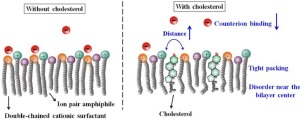Journal of the Taiwan Institute of Chemical Engineers ( IF 5.7 ) Pub Date : 2018-03-07 , DOI: 10.1016/j.jtice.2018.02.013 An-Tsung Kuo , Cheng-Lin Tu , Yu-Min Yang , Chien-Hsiang Chang

|
A pseudodouble-chain ion pair amphiphile, hexadecyltrimethylammonium-dodecylsulfate (HTMA-DS), and a double-chain cationic surfactant, ditetradecyldimethylammonium bromide (DTDAB), were used as the main materials to form positively charged catanionic vesicles with various cholesterol contents. The effects of cholesterol on physical stability of the charged catanionic vesicles were then investigated by size, zeta potential, and Fourier transform infrared analyses. With the presence of cholesterol, the physical stability of the vesicles was enhanced. The inclusion of cholesterol would increase the distance between the charged headgroups of the vesicle-forming molecules and reduce the tendency of the counterion binding onto the charged vesicle surfaces, leading to a more pronounced charge character of the vesicles. Furthermore, with the incorporation of cholesterol, the sterol ring of cholesterol tended to maximize the contact with neighboring hydrocarbon chains, thus improving the bilayer mechanical strength. In the meantime, the alkyl side-chain of cholesterol together with the segments of the hydrocarbon chains near the ends in the vesicle-forming molecules could form flexible regions within the vesicular bilayers. Thus the presence of cholesterol in the bilayer structures of HTMA-DS/DTDAB catanionic vesicles not only enhanced the inter-vesicular electrostatic repulsion but also adjusted the intra-vesicular molecular packing, resulting in improved physical stability of the vesicles.
中文翻译:

带正电荷的阳离子小泡增强的物理稳定性:胆固醇调节的分子堆积的作用
伪双链离子对两亲物,十六烷基三甲基十二烷基硫酸铵(HTMA-DS)和双链阳离子表面活性剂溴二十四烷基二甲基铵(DTDAB)被用作形成具有各种胆固醇含量的带正电荷的阳离子小泡的主要材料。然后通过大小,ζ电势和傅里叶变换红外分析研究了胆固醇对带电阳离子小泡的物理稳定性的影响。随着胆固醇的存在,囊泡的物理稳定性得到增强。胆固醇的包含将增加形成囊泡的分子的带电头基之间的距离,并降低抗衡离子结合在带电囊泡表面上的趋势,从而导致囊泡的电荷特性更加明显。此外,随着胆固醇的掺入,胆固醇的甾醇环趋于使与相邻烃链的接触最大化,从而提高双层机械强度。同时,胆固醇的烷基侧链与形成小泡的分子末端附近的烃链的链段一起可在小泡双层内形成柔性区域。因此,HTMA-DS / DTDAB阳离子小泡的双层结构中胆固醇的存在不仅增强了小泡间的静电排斥力,而且调节了小泡内的分子堆积,从而提高了小泡的物理稳定性。胆固醇的烷基侧链与形成小泡的分子末端附近的烃链的链段一起可在小泡双层内形成柔性区域。因此,HTMA-DS / DTDAB阳离子小泡的双层结构中胆固醇的存在不仅增强了小泡间的静电排斥力,而且调节了小泡内的分子堆积,从而提高了小泡的物理稳定性。胆固醇的烷基侧链与形成小泡的分子末端附近的烃链的链段一起可在小泡双层内形成柔性区域。因此,HTMA-DS / DTDAB阳离子小泡的双层结构中胆固醇的存在不仅增强了小泡间的静电排斥力,而且调节了小泡内的分子堆积,从而提高了小泡的物理稳定性。



























 京公网安备 11010802027423号
京公网安备 11010802027423号